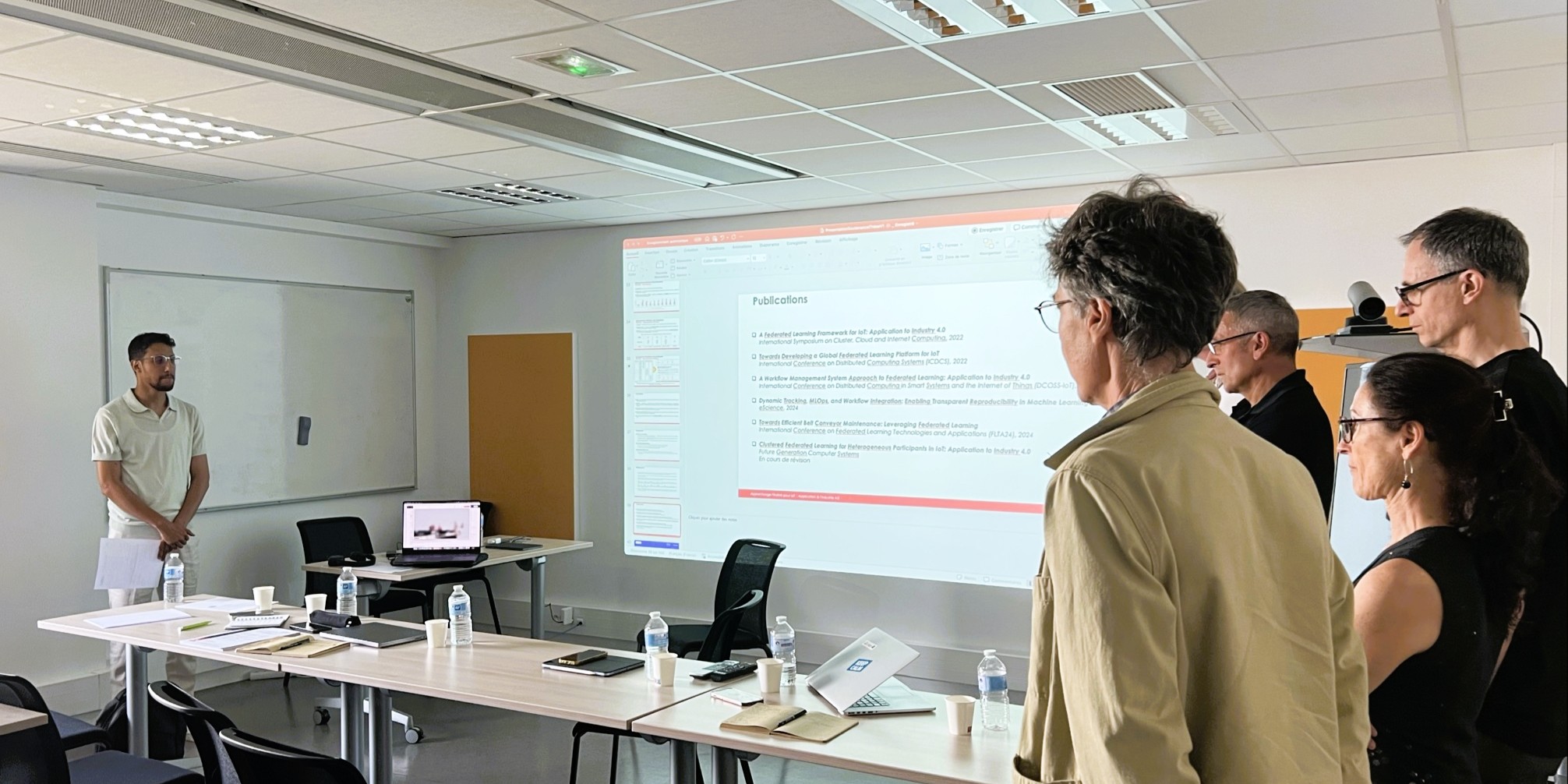Thuesday 24th June at 3pm Paris time, Hamza Safri, Ph.D. Candidate has defended his thesis named “Federated learning for the IoT: Application for Industry 4.0”. His thesis defense took place at the Inria Minatec Grenoble, Grenoble, France. Take a look at the summary below.
Keywords: Model generalization, predictive maintenance, industrial IoT, federated learning, edge network, industry 4.0
Summary
In industry, equipment failures can lead to prolonged downtimes and significant financial losses. To prevent such situations, predictive maintenance (PM) relies on technologies such as the Internet of Things (IoT), where smart sensors collect real-time data (temperature, vibrations, etc.) to detect anomalies before they cause major failures. However, managing the large volume of data generated by these sensors raises issues related to latency, as well as high costs associated with remote storage and analysis.
Edge Computing provides a solution to these challenges by allowing data to be processed and stored locally, near the sensors, which reduces latency and optimizes bandwidth usage. However, the diversity of sensors and environments makes it difficult to generalize learning models and update them at scale. Moreover, as the number of connected devices increases, model management becomes a major challenge. Each sensor or group of sensors may require a specific model, leading to a proliferation of models to maintain, synchronize, and optimize, complicating their management in a distributed environment.
It is in this context that Federated Learning (FL) emerges as a key solution. This approach allows multiple nodes (IoT sensors) to train a global model without needing to share their local data. Each node calculates the model parameters based on its own data, and then sends the results to be aggregated and improve the global model. This method reduces training and inference delays, as the computations are performed locally.
However, the combination of Edge Computing and Federated Learning in an IoT environment raises several major challenges for implementing Federated Learning. The heterogeneity of hardware and operational contexts of connected devices generates non-independent and identically distributed (Non-IID) data, making it more difficult to aggregate a reliable global model. Additionally, the limited resources of Edge devices may slow down model training or cause dropouts. The selection of participating nodes is also crucial, as limited resources in some nodes can affect the quality of the global model. Finally, the disparity between nodes in terms of resources and training time raises the issue of synchronous versus asynchronous aggregation and its impact on model convergence.
In this context, this thesis studies the implementation of Federated Learning in IoT environments. Four main contributions have been developed to adapt this approach to the specific characteristics of these environments. First, a Federated Learning architecture adapted to IoT networks has been proposed, detailing the interactions between the Edge and Cloud layers. Then, to overcome the challenges related to computational resource heterogeneity, a stacking-based aggregation approach, called FedStack, has been developed. This approach accounts for automatic methods while maintaining model personalization for each connected device. Another contribution proposed a federated learning grouping approach to better manage data heterogeneity and more specifically address statistical heterogeneity, unlike FedStack, which is based on model personalization. In this approach, the data from participants represent the central element and are grouped according to their statistical behaviors, ensuring maximum homogeneity of the data.
These contributions were studied and validated through a real-world case study in the industrial sector. This case involved several conveyor belts located in different airports, used to collect data and assess the proposed approaches in the context of predictive maintenance. A comprehensive study was conducted to evaluate all the approaches, including a participant selection method tailored to the airport context. This method used contextual elements, such as the airport load, to choose optimal training times and identify less-loaded Edge nodes.
The jury was composed of:
Examiners:
- Kermarrec Anne-Marie – Examiner, Federal Polytechnic School of Lausanne
- Denneulin Yves – Examiner, Grenoble INP – UGA
- Nicod Jean-Marc – Rapporteur, National Higher School of Mechanics and Microtechnology
- Travé-Massuyès Louise – Rapporteur, CNRS West Occitanie Delegation
Supervisors:
- Desprez Frederic – Director, Inria Center University Grenoble Alpes
- Trystram Denis – Co-Director, Grenoble INP – UGA
Guests:
- Kandi Mohamed Mehdi – Research engineer, Berger-Levrault
- Miloudi Youssef – Director of BL.Predict, Berger-Levrault
Scientific Publications:
(2022) A Federated Learning Framework for IoT: Application to Industry 4.0: https://ieeexplore.ieee.org/abstract/document/9825974
(2022) Towards Developing a Global Federated Learning Platform for IoT: https://ieeexplore.ieee.org/abstract/document/9912211
(2024) Towards Efficient Belt Conveyor Maintenance: Leveraging Federated Learning: https://ieeexplore.ieee.org/document/10839891





